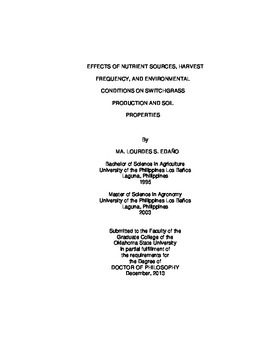| dc.contributor.advisor | Wilson, Gail W. T. | |
| dc.contributor.advisor | Zhang, Hailin | |
| dc.contributor.author | Edano, Ma. Lourdes S. | |
| dc.date.accessioned | 2015-06-17T20:05:42Z | |
| dc.date.available | 2015-06-17T20:05:42Z | |
| dc.date.issued | 2013-12 | |
| dc.identifier.uri | https://hdl.handle.net/11244/14817 | |
| dc.description.abstract | Switchgrass is considered a promising low-input biofuel feedstock. Previous development primarily focused on aboveground production, however, feedstock success will depend on identifying sustainable management practices that increase biomass yield for multiple purposes, while increasing soil quality. In this multi-site field study, effects of fertilizer and harvesting regimes on soil properties (Chapter 1) and above- and belowground biomass (Chapter 2) were assessed. A complementary greenhouse study assessed fertilizer management and environment (Chapter 3). | |
| dc.description.abstract | The field study evaluated soil organic matter (SOM), NO3-N, plant-available phosphorous (P), soil aggregate stability and microbial communities following applications of organic (cattle manure, poultry litter) and inorganic fertilizers, and inter-seeded legumes. A control (no fertilizer) was also included. Harvesting regimes included single harvest in the fall, and two harvests per year. The study was conducted in 2011 and 2012 at two central Oklahoma sites with previously established switchgrass (Alamo). Regardless of harvest frequency, application of poultry litter increased aboveground biomass and soil NO3-N, P, SOM, and arbuscular mycorrhizal fungal biomass, compared with the control. The use of organic fertilizer and inorganic NPK increased soil macroaggregates in the single harvest plots, compared to the control, which may improve water infiltration and decrease soil and nutrient loss due to water erosion. While the use of poultry litter increased aboveground biomass, soil P was markedly increased as well. Therefore, soil should be closely monitored to avoid P build-up and subsequent P loss to the environment. | |
| dc.description.abstract | The greenhouse study assessed above- and belowground parameters under different climatic conditions and fertilizer management. Increases in temperature and drought did not generally affect above- or belowground parameters. The only microbial community affected was mycorrhiza, with greater abundance under ambient, compared to warmer, drier conditions. This research supports switchgrass as a model perennial bioenergy crop producing high yields on marginal lands under wide environmental conditions. | |
| dc.format | application/pdf | |
| dc.language | en_US | |
| dc.rights | Copyright is held by the author who has granted the Oklahoma State University Library the non-exclusive right to share this material in its institutional repository. Contact Digital Library Services at lib-dls@okstate.edu or 405-744-9161 for the permission policy on the use, reproduction or distribution of this material. | |
| dc.title | Effects of nutrient sources, harvest frequency, and environmental conditions on switchgrass production and soil properties | |
| dc.contributor.committeeMember | Ochsner, Tyson E. | |
| dc.contributor.committeeMember | Desta, Kefyalew Girma | |
| osu.filename | Edano_okstate_0664D_13016.pdf | |
| osu.accesstype | Open Access | |
| dc.type.genre | Dissertation | |
| dc.type.material | Text | |
| dc.subject.keywords | amf | |
| dc.subject.keywords | bioenergy | |
| dc.subject.keywords | soil microorganisms | |
| dc.subject.keywords | switchgrass | |
| thesis.degree.discipline | Soil Science | |
| thesis.degree.grantor | Oklahoma State University | |
